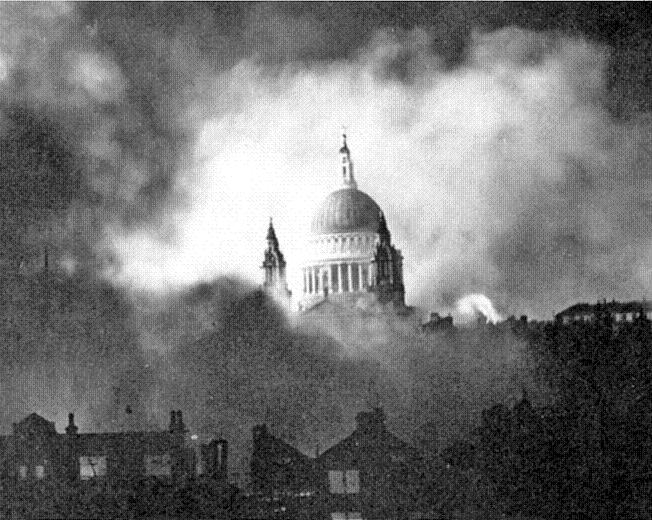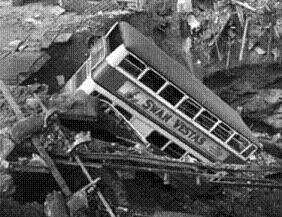|
    
The Blitz
|
|
Hitler expects to terrorise and cow the people of this
mighty city… Little does he know the spirit of the British nation, or the
tough fibre of the Londoners.
Winston Churchill, broadcast 11 September 1940.
All reports from London are agreed that the population is seized by fear.
The Londoners have completely lost their self-control..
Nazi-controlled French radio, 18 September 1940.
|
Going Deeper
Photos
- The History Place
People at War - BBC
 The BBC site on The Blitz: Myth and Reality
Coventry Blitz
YouTube
Twentieth Century History - Britain Alone - fabulous
London Can Take It! - classic American documentary, which played an important part in bringing the USA into the war
Short documentary
Personal memories
Ernie Pyle
Bernard Bergonzi
An extract from Norman Longmate's fantastic book: How We Lived Then
|
|
The city was in darkness
Thick black-out material (at 2 shillings a yard) prevented any gleam of light from the windows.
At the start of the Blitz people feared even to strike a match.
Many things (including pavement edges) were painted white; pedestrians ‘wore something white at night’.
They lost their way, walked into canals, bumped into lampposts.
Car headlights were hooded.
It was said that more people died from traffic accidents than from Nazi bombs.
Only criminals, lovers and astronomers loved the Blackout.
Fire-watchers and street wardens stayed awake all night listening for any attack.
Things were not always as well-organised as they might be; my mother was put
on listening duty, even though she was deaf.
The sirens sounded.
Some mothers grabbed their children and went out to the Anderson shelter in the garden – brightened up with flowers growing on the roof, and pictures, even wallpaper, on the walls.
They took with them birth certificates, Post Office books, First Aid kit and personal treasures.
Others preferred to shelter under the Morrison shelter in the sitting room, or in the cupboard under the stairs.
In the City, thousands were sleeping the night in the Underground, or in fouling-smelling public shelters.
In places such as Coventry and Plymouth, many people had left the city and
gone to sleep outside in the surrounding countryside.
Then came the throb of plane engines.
People could tell the different enemy planes by their engines, as they could tell them by their shapes.
The engines seemed to be saying: ‘Where are you?
Where are you?’ Anti-aircraft (‘ack-ack’) guns opened fire – people were killed by their shells falling back to earth.
|
Air Raid Precautions
(the measures taken to prepare for Nazi bombing attacks)
Here is a list:
• gas masks
•
the blackout
•
barrage balloons, search lights and ack-ack (anti-aircraft) guns
•
sirens
•
shelters (including Anderson, Morrison, public
shelters, and The London Underground).
•
equipment (included sandbags, taping windows, stirrup pump, incendiary bomb scoop)
•
(evacuation was a form of ARP)
•
Civil defence services (included the Auxiliary Fire Service, First Aiders and amublancemen)
•
27,000 volunteers in the Royal Observer Corps (listening for bombers at night/ looking for planes or doodlebugs during the day)
•
Schools and churches had their own ARP arrangements (like schools have drills today)
•
booklets and cigarette cards giving advice to householders
•
ARP wardens were not just officious men who went round shouting 'put that light out'.
In the event of an 'incident', they coordinated the casualty services, the WVS and the boy scouts (who ran messages).
|
|
Down came the bombs.
High explosives (HEs) blew up buildings.
Incendiaries caused fires and were dropped in clusters called ‘breadbaskets’ or ‘Molotovs’.
Later in the war, the Nazis dropped parachute bombs – which exploded when they touched the earth.
Unable to see where the factories were, the bombers resorted to ‘carpet- bombing’.
90% of houses in London were damaged.
On the night of 14-15 November 1940 Coventry was so badly bombed that the Nazis coined a new word: ‘coventrate’ – meaning to destroy a whole city.
Winston Churchill visited Coventry.
‘They have sown the wind, they shall reap the whirlwind’, he said.
Later in the war he sent 1,000-bomber raids to attack German cities.
Many German civilians were killed; some people nowadays say Churchill was wrong, but during the war many British people thought it served them right.
|
Source A
It has started! If they keep this up for another week, the war will be over.
The East End won’t be able to stand much more of this sort of thing.
What’s more, the Fire Brigade won’t be able to stand much more of it either.
This is the first leave I’ve had since Thursday…
Down came the bombs.
You could hear the HEs going over the top with a low whistling sound.
After a moment or two they started in with the incendiaries and dropped a Molotov over the docks.
There was fire in every direction.
The City was turned into an enormous, loosely-stacked furnace, belching black smoke.
London Air Raid Warden, speaking in January 1941.
|
Source B

This photograph, published in the Daily Mail in December 1940 – showing St Paul’s towering over the fires of the Blitz – was called by the newspaper: ‘the Greatest Picture of the War’.
It had symbolic meaning to the people at the time - can you think what?
|
|
Not everybody sheltered during a raid.
Firemen fought the fires.
Fire-watchers tried to put out incendiaries.
Rescue workers dug for buried people.
Next day
Those who could tried to get on with their lives.
The homeless went to government rest centres.
The Women’s Voluntary Service provided cups of tea and blankets.
Bomb disposal men tried to disarm UXBs (unexploded bombs).
It was a dangerous job; many UXBs were booby-trapped.
Not everybody behaved bravely.
Some people talked about surrendering.
In the East End of London, there was some looting.
The government’s Mass
Observation researchers were worried.
|
Source C

A photograph from 1941 of bus which had fallen into the crater of a bomb which blasted through the roof of an underground railway station.
The government did not allow this photograph to be published; can you think why?
|
Source D
The British nation is stirred and moved as it never has been at any time in its long and famous history, and they mean to conquer or to die.
What a triumph the life of these battered cities is over the worst that fire and bomb can do!
The terrible experiences and emotions of the battlefield are now shared by the entire population.
Old men, little children, the crippled, the veterans of former wars, aged women, the hard-pressed citizen, the sturdy workman with his hammer in the shipyard, the members of every kind of ARP service, are proud to feel that they stand in the line together with our fighting men.
This, indeed, is a grand, heroic period of our history, and the light of glory shines upon all.
Winston Churchill, broadcast 27 April 1941.
|
Source E
I just went down to the Post an’ when I came back my street was as flat as this ‘ere wharfside – there was just my ‘ouse like – well, part of my ‘ouse.
My missus was just making me a cup of tea for when I came ‘ome.
She were in the passage between the kitchen and the wash-‘ouse, where it blowed ‘er.
She were burnt right up to ‘er waist.
‘Er legs were just two cinders… and ‘er face… The only thing I could recognize ‘er by was one of ‘er boots…
I’d ‘ave lost fifteen ‘omes if I could ‘ave kept my missus.
Hull Air Raid Warden.
|
|
|
Spotted an error on this page? Broken link?
Anything missing? Let me know.
|
    
|

